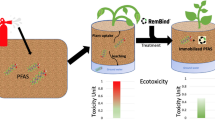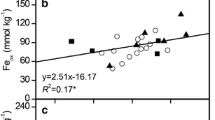Abstract
Various properties of soil affect the partition of organic contaminants within, and conversely, the properties of the organic contaminants also directly affect their partition behavior in soil. Therefore, understanding the effects of various properties of soil on the partition of organic contaminants favors subsequent assessment and provides soil remediation methods for policymakers. This study selected pentachlorophenol (PCP), a common hydrophobic ionizable organic compound in contaminated sites worldwide, as the target contaminant. The effects of pH, organic matter, and the combination of both, on PCP adsorption/desorption behavior in soil were investigated. Phosphoric acid and potassium hydroxide were used as buffer solutions to modify the soil pH by the batch and column extraction methods. A common retail organic fertilizer and fulvic acid were selected as additives to manipulate the soil organic content. Modifying the pH of the soil samples revealed that acidic soil exhibited a greater PCP adsorption rate than alkaline soil. The amount of PCP desorption increased regardless of pH of the in situ contaminated soil. The adsorption of PCP increased with increasing amount of organic additive. However, addition of fulvic acid yielded different results compared to the addition of organic fertilizer. Specifically, the organic fertilizer could not compete with the in situ contaminated soil in PCP adsorption, whereas fulvic acids increased the PCP dissolution to facilitate adsorbing contaminant adsorption. The combined effect of pH modification and organic matter addition provides additional PCP adsorption sites; therefore, adding the organic fertilizer to decrease the soil pH elevated the PCP adsorption rates of the laterite, alluvial, and in situ contaminated soil samples. The study results revealed that both pH and organic matter content are crucial to PCP adsorption/desorption in soil. Therefore, the effects of soil pH and organic matter should be considered in facilitating PCP treatment for soil remediation.








Similar content being viewed by others
References
Ahmed AA, Thiele-Bruhn S, Aziz SG, Hilal RH, Elroby SA, Al-Youbi AO, Leinweber P, Kühn O (2015) Interaction of polar and nonpolar organic pollutants with soil organic matter: sorption experiments and molecular dynamics simulation. Environ Sci Technol 508:276–287
Baker JI, Hites RA (2000) Siskwit Lake revisited: time trends of polychlorinated dibenzo-ρ-dioxin and dibenzofuran deposition at Isle Royale, Michigan. Environ Sci Technol 34:2887–2891
Cheng G, Zhu L, Sun M, Deng J, Chen H, Xu X, Lou L, Chen Y (2014) Desorption and distribution of pentachlorophenol (PCP) on aged black carbon containing sediment. J Soils Sediments 14(2):344–352
Diagboya PN, Olu-Owolabi BI, Adebowale KO (2016) Distribution and interactions of pentachlorophenol in soils: the roles of soil iron oxides and organic matter. J Contam Hydrol 191:99–106
DiVincenzo JP, Sparks DL (2001) Sorption of the neutral and charged forms of pentachlorphenol on soil: evidence for different mechanisms. Arch Environ Contam Toxicol 40:445–450
Environmental Protection Administration (2017) Soil Pollution Monitoring Standard. (visit on 11/10/2016) https://sgw.epa.gov.tw/public/07_Pollutant.asp?polluMethod=Soil, Soil and groundwater pollution remediation fund management board, Environmental Protection Administration, R.O.C. (Taiwan)
Fisher B (1991) Pentachlorophenol: toxicology and environmental fate. J Pestic Reform 11:2–5
Ghosh U, Talley JW, Luthy RG (2001) Particle-scale investigation of PAH desorption kinetics and thermodynamics from sediment. Environ Sci Technol 35:3468–3475
Ghosh U, Gillette JS, Luthy RG, Zare RN (2000) Microscale location, characterization, and association of polycyclic aromatic hydrocarbons on harbor sediment particles. Environ Sci Technol 34:1729–1736
Hamker JW, Thompsom JM (1972) Adsorption. In: Goring CAI, Hamaker JW (eds) Organic chemicals in soil environment, vol 1. Marcel Dekker, Inc., New York
Huang, R. Y (2014) Treatment of pentachlorophenol in soil and ground water by electrochemistry technology. Doctoral dissertation, National Chung Hsing University. pp 240
Hung KH (1996) Soil chemistry. National Compilation and Translation Center, Taipei, p 219
Esteves da Silva JCG, Marques MCPO (2007) Pentachlorophenol association with fulvic acids from recycled wastes. Environ Pollut 146:174–179
Johnson CR, Lamar RT (1997) Binding of pentachlorophenol to humic substances in soil by the action of white rot fungi. Soil Biol Biochem l29:1143–1148
Johnson WP, Amy GL (1995) Facilitated transport and enhanced desorption of PAHs by natural organic in aquifer sediments. Environ Sci Technol 29:807–817
Kile DE, Chiou CT, Zhou H, Li H, Xu O (1995) Partition of nonpolar organic pollutants from water to soil and sediment organic matters. Environ Sci Technol 29:1401–1406
Laor Y, Strom PF, Farmer WJ (1999) Bioavailability of phenanthrene sorbed to mineral-associated humic acid. Original Research Article. Water Res 33:1719–1729
Paaso N, Peuravuori J, Lehtonen T, Pihlaja K (2002) Sediment-dissolved organic matter equilibrium partitioning of pentachlorophenol: the role of humic matter. Environ Inter 28:173–183
Peng P, Lang YH, Wang XM (2016) Adsorption behavior and mechanism of pentachlorophenol on reed biochars: pH effect, pyrolysis temperature, hydrochloric acid treatment and isotherms. Ecol Eng 90:225–233
Peuravuori J, Paaso N, Pihlaja K (2002) Sorption behaviour of some chlorophenols in lake aquatic humic matter. Original research article. Juhani Peuravuori, Nina Paaso, Kalevi Pihlaja 56:523–538
Ping LF, Luo YM (2005) Research progress on the effect of organic matter on environmental behavior of polycyclic aromatic hydrocarbons. Soils 37:362–369
Raber B, Kögel-Knabner I, Stein C, Klem D (1998) Partitioning of polycyclic aromatic hydrocarbons to dissolved organic matter from different soils. Chemosphere 36:79–97
Richnow HH, Seifert R, Hefter J, Kastner M, Mahro B, Michaelis W (1994) Metabolites of xenobiotica and mineral oil constituents linked to macromolecular organic matter in polluted environments. Org Geochem 22:671–681
Schwarz, J., Thiele-Bruhn, S., Eckhardt, K. U., and Schulten, H. R (2012) Sorption of sulfonamide antibiotics to soil organic sorbents: batch experiments with model compounds and computational chemistry. ISRN Soil Sci.Volume 2012. pp.10. doi:10.5402/2012/159189
Thiele-Bruhn S, Aust MO (2004) Effects of pig slurry on the sorption of sulfonamide antibiotics in soil. Arch Environ Contam Toxicol 7:31–39
Wang YX, Chen ZX, Li DY (1995) Soil pollution studies. National Aeronautical University, Taipei, pp 73–126
Weber WJ Jr, Huang W, Yu H (1998) Hysteresis in the sorption and desorption of hydrophobic organic contaminants by soils and sediments. 2. Effects of soil organic matter heterogeneity. J Contam Hydrol 31:149–165
Xia G, Ball WP (1999) Adsorption-partitioning uptake of nine low polarity organic chemicals on a natural sorbent. Environ Sci Technol 33:262–269
Xing B, Pignatello JJ (1997) Dual-mode sorption of low-polarity compounds in glassy poly (vinyl chloride) and soil organic matter. Environ Sci Technol 31:792–799
Author information
Authors and Affiliations
Corresponding author
Additional information
Responsible editor: Guilherme L. Dotto
Rights and permissions
About this article
Cite this article
Chien, SW.C., Chen, SH. & Li, CJ. Effect of soil pH and organic matter on the adsorption and desorption of pentachlorophenol. Environ Sci Pollut Res 25, 5269–5279 (2018). https://doi.org/10.1007/s11356-017-9822-7
Received:
Accepted:
Published:
Issue Date:
DOI: https://doi.org/10.1007/s11356-017-9822-7




